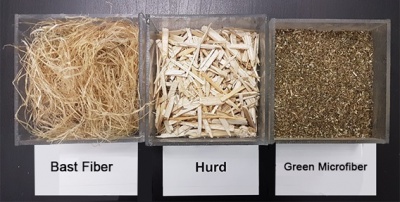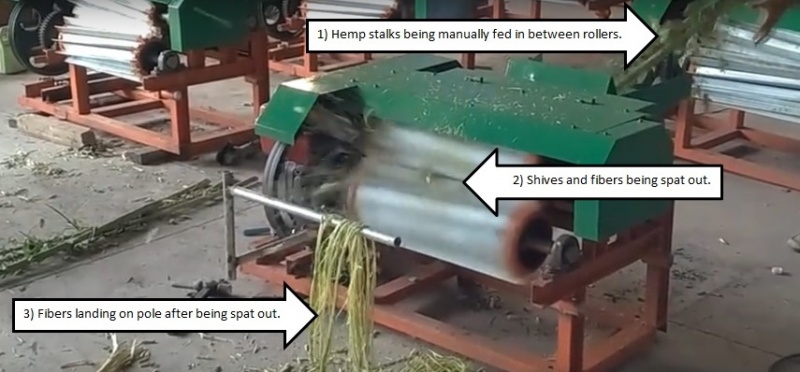Hemp Decorticator: Difference between revisions
m (Marcin moved page Hemp decorticator to Hemp Decorticator) |
No edit summary |
||
| Line 16: | Line 16: | ||
Several hemp stalks are simultaenously fed into one end of the machine, in between a pair of rollers. | Several hemp stalks are simultaenously fed into one end of the machine, in between a pair of rollers. | ||
A Feeding hopper can facilitate feeding and permit a distance between the user and the moving parts of the machine for safety. | |||
The | The stalks are crushed into shives between the roller pair and the soft bast fibers are separated from the woody interior off the stalk. | ||
The rollers are connected via a | The blades of all rollers are blunt. That way, fibers are not damaged, but stalks are still crushed into hurd and the fiber is separated from the stalk. | ||
First pair of rollers roll the stalks into the second pair of rollers. | |||
The second pair of rollers spin at a different rpm than the first pair and further crushes stalk into hurd while separating fiber. | |||
Hurd and fibers are spat out from in between the second pair of rollers. | |||
Fibers are "caught" on a Horisontal pole placed close to the second roller pair. | |||
Hurd can be caught in a Net surrounding the output-end of the machine. | |||
The rollers are connected via a gears and driven by a 7.5 kW motor. The roller are supported by bearings positioned at each end of the shafts. | |||
[[File:Hemp decorticator.jpg|800px]] | [[File:Hemp decorticator.jpg|800px]] | ||
| Line 29: | Line 43: | ||
[[File:Hemp_decorticator_2.jpg|400px|right]] | [[File:Hemp_decorticator_2.jpg|400px|right]] | ||
== | == Bill of Materials == | ||
{| class="wikitable sortable" | |||
!Item no. | |||
!Quantity | |||
!Item | |||
!Description | |||
|- | |||
| 1 || 4 || Bladed roller || Welded component made from four sub-components. | |||
|- | |||
| 1.2 || 4 || Tube || Blades and lids are welded to this part. | |||
|- | |||
|} | |||
== See also == | == See also == | ||
Revision as of 14:56, 4 January 2020
A hemp decorticator is a machine that separates hemp stalks in to different materials that are used for a vast array of products;
· Bast fiber; for plastics including 3D printer filament, composite materials, textile, etc.
· Hurd (also called shives); for paper, hempcrete, insulation, fibre board, etc.
· Green microfiber; beauty products, CBD, nutritional products, etc.
Hemp seeds can also be used and turned in to food products, ink, paint, lubricant, etc.
Working principle
Several hemp stalks are simultaenously fed into one end of the machine, in between a pair of rollers.
A Feeding hopper can facilitate feeding and permit a distance between the user and the moving parts of the machine for safety.
The stalks are crushed into shives between the roller pair and the soft bast fibers are separated from the woody interior off the stalk.
The blades of all rollers are blunt. That way, fibers are not damaged, but stalks are still crushed into hurd and the fiber is separated from the stalk.
First pair of rollers roll the stalks into the second pair of rollers.
The second pair of rollers spin at a different rpm than the first pair and further crushes stalk into hurd while separating fiber.
Hurd and fibers are spat out from in between the second pair of rollers.
Fibers are "caught" on a Horisontal pole placed close to the second roller pair.
Hurd can be caught in a Net surrounding the output-end of the machine.
The rollers are connected via a gears and driven by a 7.5 kW motor. The roller are supported by bearings positioned at each end of the shafts.
Bill of Materials
| Item no. | Quantity | Item | Description |
|---|---|---|---|
| 1 | 4 | Bladed roller | Welded component made from four sub-components. |
| 1.2 | 4 | Tube | Blades and lids are welded to this part. |


